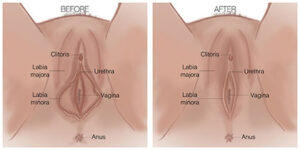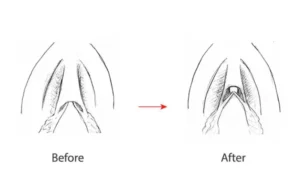Genital Aesthetic Surgery: Everything You Need to Know
Click for Quick Consultation at vituras
Genital aesthetic surgery, also known as vaginal rejuvenation, is a type of cosmetic surgery that can improve the appearance and function of the female genital area. It is a popular procedure among women of all ages, and it can be a great way to boost confidence and improve sexual satisfaction.
Types of Genital Aesthetic Surgery
There are a variety of different genital aesthetic surgery procedures available, each of which is designed to address a specific issue. Some of the most common procedures include:
Labioplasty:

This procedure is used to reduce the size or reshape the labia minora, which are the inner lips of the vagina.
Vaginoplasty: This procedure is used to tighten the vaginal opening and improve muscle tone.
Clitoral hood reduction:

This procedure is used to reduce the size of the clitoral hood, which is the skin that covers the clitoris.
Vaginal rejuvenation laser:

This procedure uses laser energy to tighten the vaginal opening and improve collagen production.
Who Is a Candidate for Genital Aesthetic Surgery?
Genital aesthetic surgery is a safe and effective procedure for women of all ages who are unhappy with the appearance or function of their genital area. Some of the most common reasons women choose to have genital aesthetic surgery include:
Asymmetry:
The labia minora can be asymmetrical in size or shape, which can be a source of embarrassment or discomfort.
Discoloration:
The labia minora can darken over time due to hormonal changes or childbirth.
Looseness:
The vaginal opening can become loose after childbirth or aging.
Inability to achieve orgasm:
Some women find that they are unable to achieve orgasm due to a lack of clitoral stimulation.
Preoperative Considerations
Before undergoing genital aesthetic surgery, it is important to meet with a qualified surgeon to discuss your goals and expectations. The surgeon will also need to perform a physical exam to assess your candidacy for the procedure.
In some cases, the surgeon may recommend that you wait until after childbirth or menopause to have genital aesthetic surgery. This is because pregnancy and menopause can cause further changes to the genital area.
Postoperative Care
Genital aesthetic surgery is typically an outpatient procedure, which means that you will be able to go home the same day. However, you will need to take it easy for a few days after surgery. You may also experience some pain and swelling, which can be managed with over-the-counter pain medication.
Complications
Genital aesthetic surgery is a safe procedure, but there are some potential complications that can occur. These include:
Infection:
Infection is a rare complication, but it can be serious if it is not treated promptly.
Hematoma:
A hematoma is a collection of blood under the skin. It can be painful and unsightly, but it is usually resolved with conservative treatment.
Nerve damage:
Nerve damage is a rare complication, but it can cause numbness or tingling in the genital area.
Results
The results of genital aesthetic surgery can be dramatic. Most women who have the procedure report being happier with the appearance and function of their genital area.
Genital aesthetic surgery is a safe and effective procedure that can improve the appearance and function of the female genital area. If you are unhappy with the appearance or function of your genital area, talk to your doctor about whether genital aesthetic surgery is right for you.
The Choice is Yours: Navigating the World of Surgical and Non-Surgical Genital Aesthetics
The realm of genital aesthetics holds a diverse spectrum of procedures, catering to women seeking to enhance their self-confidence and improve their intimate well-being. But within this spectrum lies a crucial question: when to choose surgery and when to opt for non-surgical alternatives? Understanding the strengths and limitations of each approach empowers you to make informed decisions aligned with your specific needs.
Surgical Procedures: Addressing Structural Changes and Functionality
Surgical genital aesthetic procedures, often referred to as vaginal rejuvenation, utilize advanced techniques to address more pronounced concerns. These interventions are ideal for:
- Significant Labial Asymmetry: When the labia minora differ greatly in size or shape, causing discomfort or affecting self-image, labiaplasty offers a permanent solution.
- Vaginal Laxity: Following childbirth or aging, the vaginal canal can loosen, impacting sexual satisfaction and function. Vaginoplasty effectively tightens the vaginal muscles and tissues.
- Clitoral Hood Redundancy: Excess tissue covering the clitoris can hinder stimulation and orgasm. Clitoral hood reduction removes this excess skin, enhancing sensitivity and pleasure.
- Functional Issues: If you experience stress urinary incontinence or pelvic floor dysfunction, surgical procedures can address the underlying anatomical deficiencies.
Non-Surgical Procedures: Gentle Enhancements and Rejuvenation
For more subtle changes or concerns about intimate aging, non-surgical options offer less invasive solutions, often with minimal downtime. These treatments are well-suited for:
- Mild Labial Concerns: If your labia minora are slightly enlarged or uneven, but not causing significant discomfort, laser rejuvenation or hyaluronic acid fillers can subtly reshape and volumize them.
- Mild Vaginal Laxity: For minor loosening, laser therapy can stimulate collagen production and tighten the vaginal tissues, improving tone and sensation.
- Vulvar Discoloration: Laser treatments target pigment-producing cells, lightening darkened labia majora and restoring a more even complexion.
- Improved Lubrication: If dryness is a concern, hyaluronic acid injections can enhance vaginal moisture and comfort.
Understanding Your Options: A Balanced Approach
Choosing the right path requires an honest self-assessment and open communication with your doctor. Consider these factors:
- Severity of Concern: Address more pronounced structural changes with surgery, while subtle enhancements might benefit from non-surgical options.
- Desired Outcome: Define your main goals, whether it’s improving appearance, function, or sexual satisfaction.
- Downtime and Risk Tolerance: Surgical procedures involve longer recovery times and potential complications, while non-surgical methods often require multiple sessions but have minimal downtime.
- Cost and Insurance Coverage: Surgery generally carries higher costs, while non-surgical options vary depending on treatments and frequency. Insurance might cover functional procedures, but not purely aesthetic ones.
Remember, a combination of surgical and non-surgical techniques can tailor a treatment plan to your unique needs. Prioritize open communication with your doctor to explore and personalize your journey towards enhanced confidence and intimate well-being.
By understanding the strengths and limitations of both surgical and non-surgical genital aesthetic procedures, you can make informed decisions that align with your personal goals and desires. Ultimately, the choice is yours, and with the right guidance, you can embark on a path towards enhanced confidence and satisfaction within your intimate self.
Remember, this is just a starting point. Don’t hesitate to expand on this content with specific information about different procedures, recovery times, potential risks, and costs. You can also include personal anecdotes or expert opinions to personalize the blog post further.
Visit vituras for more detailed information and consultation.
You can also read our the article about breast surgery>>












One thought on “Genital Aesthetic Surgery: Everything You Need to Know”